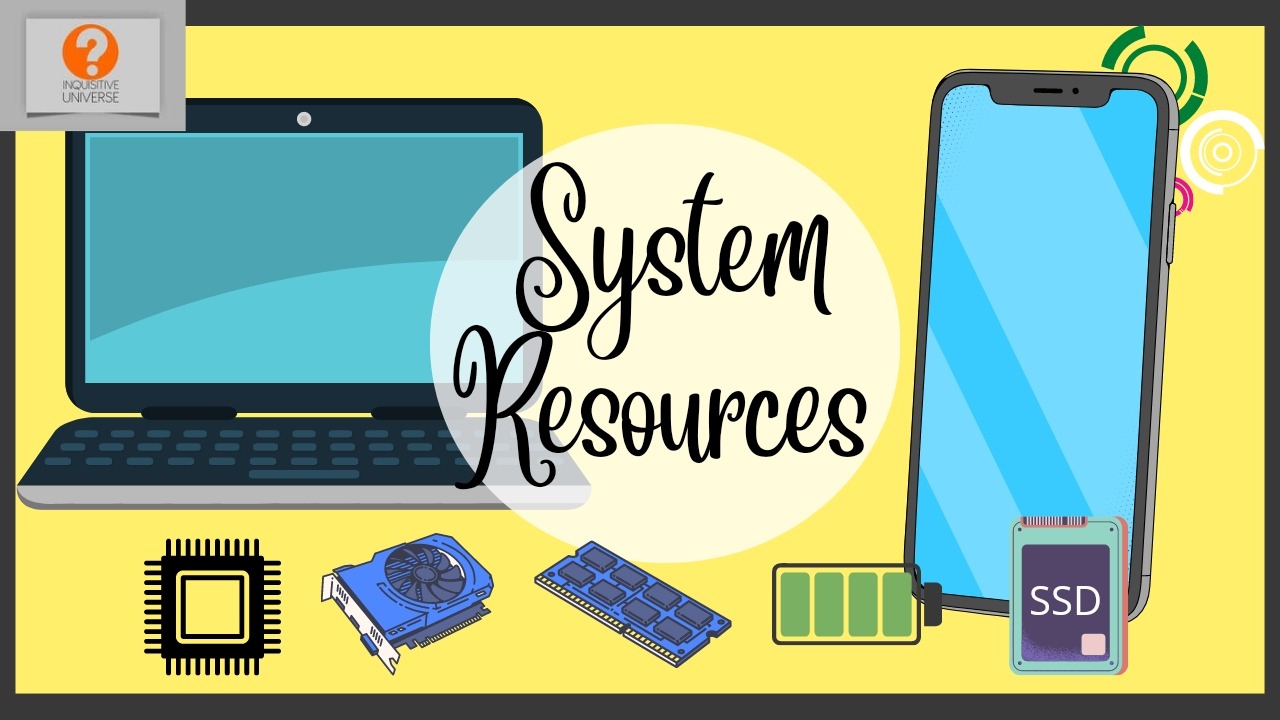What are system resources? In very simple terms, a system resource is any component of the phone/computer that is needed to carry out tasks. These components may include both hardware and software.
Anything that a system needs to function that is not infinite is considered a system resource.
System resources include:
- CPUs and GPU
- RAM (memory)
- Storage
- Battery
There could be others but these are the major system resources on a smartphone.
CPU and GPU
The CPUs are an obvious one. They handle all of the processing tasks that the phone has to undergo. CPUs have what is known as bandwidth.
Think of CPUs as a road lane and each lane is one bit. So a road (CPU) with 16 lanes can be considered a 16-bit CPU. A road (CPU) with 32 lanes is a 32-bit CPU and a road with 64 lanes is a 64-bit CPU.
Now some tasks are heavier than others and would require more lanes (bits) while some would use less.
Eight cars (8-bit tasks) can pass through an 8-lane road at once. Eight cars (8-bit tasks) will pass through a 16-lane road even more easily.
16 cars (16-bit tasks) will easily pass through a 32-lane road (32-bit CPU) or 64-lane road (64-bit CPU).
But when a 32-bit task is fed to a 16-bit CPU, the CPU will not have enough resources (space or bandwidth) to handle the task.
The same thing can be said when a 64-bit task like eFootball Mobile is given to a 32-bit CPU like a Cortex A7 or A9. Something that many people have soon begun to realize rather abruptly.
If a CPU does not have enough resources to handle a specific task, it will be unable to carry it out.
In the same way, a 16-lane road cannot allow more than 16 cars to pass at the same time. The same thing that can be said about the CPUs also applies to the GPUs.
RAM
RAM or random access memory is also another important system resource. This is because it is where the CPU stores tasks that it is working on. If a CPU can handle a task, it will save the running app to the RAM.
Now some tasks occupy more space in memory than others. It is not enough that the CPUs/GPU can handle a task, if there’s not enough RAM to save the app/task to, it won’t work. The message that will grace the screen will be out of/not enough memory.
This is where RAM size is important. It allows the CPUs to be able to work on more/bigger apps without the fear of running out of memory.
Most OS is programmed to ensure that there’s always enough RAM space because it is a very important system resource. To prevent some apps from using too much RAM space, Android has a 4GB RAM limit for all tasks that developers must adhere to.
Most Android skins also have a general RAM limit that must not be exceeded when allocating RAM resources to apps/tasks. In 2018, you could play PES and PUBG with a 2GB RAM device, in 2023, that will not happen.
Storage
Storage is also a very important resource, although it is not as important as the aforementioned trio.
The OS saves massive amounts of cache to the storage and if there’s not enough storage, the system functions will slow down. In serious cases of low storage, the phone will lag or even go into a boot loop.
See: Why do phones become slow when there’s low space?
Battery
The last one on the list is the battery. The battery is a very important system resource without which the entire system ceases to function entirely.
If you are a gamer like me or a heavy user, you would have noticed by now that games tend to use more battery than other apps. The other apps can also have different levels of battery consumption depending on the circumstances.
A very good example is the network app using minimal battery when there’s a stable signal and using a lot of battery when the signal is poor. Other apps like Facebook are simply power-hungry and tend to run in the background even when you shut them off. They will keep using the battery regardless.
This is why sometimes when my battery begins to drain unnecessarily, I would kill off all background tasks and then manually give permissions to the apps that are important to me.
Sometimes it is also necessary to check your network connections as that could be the culprit behind your battery.
PS: Those signal bars don’t mean shit.
See: How to check signal strength
Conclusion
If you’re a regular user who doesn’t game or do heavy tasks with their phone, then phones with 32-bit CPUs would do you fine.
If not, ensure that you buy a phone with 64-bit CPUs. Any phone with a CPU around or above Cortex A73 would serve you well.
Although some manufacturers may choose to limit their phones to only 32-bit tasks even though they have 64-bit CPUs.
I remember the case of Redmi 9C. The Redmi 9C has a Helio G35 SoC with Cortex A53 CPUs but it was a 32-bit phone which was rather surprising.
Someone also complained to me that the Infinix Hot 10i as well does not support eFootball meaning that the manufacturer has restricted it to 32-bit tasks. This is despite the fact that it uses Helio G70 with A75 CPUs
So to wrap up, System resources refer to the components that a phone/PC needs to handle tasks. If these resources are readily available, the phone will carry out the task. If they’re not available then it wouldn’t be able to do so.
Please leave a comment if you have any difficulty and remember to:
- Subscribe to our YouTube channel
- Follow on Facebook
- Join our Telegram community
- Participate on Reddit
- Find us on Quora


